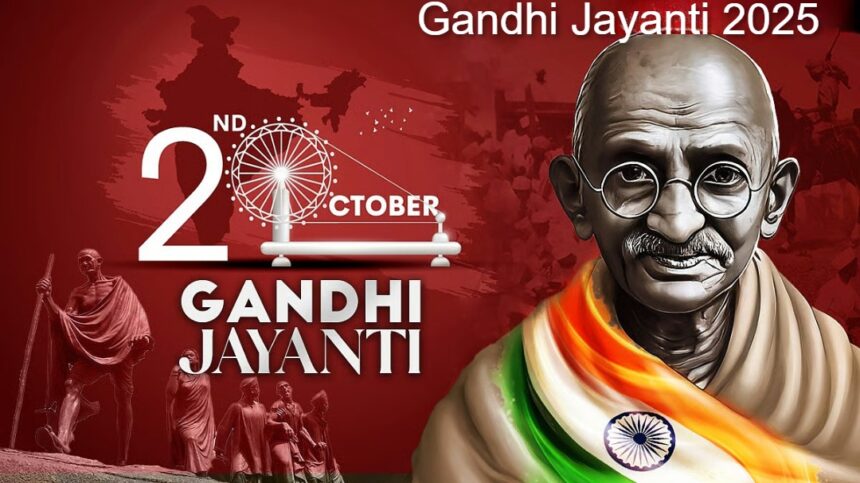Imagine a man in simple white cloth leading millions toward freedom without raising a fist. That’s Mahatma Gandhi, whose ideas still shape India’s heart. In 2025, Gandhi Jayanti on October 2 calls us to pause and think about peace in a noisy world. This national holiday marks his birthday and honors non-violence. As global tensions rise, it feels more urgent than ever. This article dives into its history, why it matters now, key facts, and ways to celebrate. You’ll see how Gandhi’s lessons can guide us today.
The Historical Background of Gandhi Jayanti
Gandhi Jayanti grew from one man’s life into a symbol of India’s fight for freedom. It started with his birth and built through years of struggle. Understanding this background shows why October 2 holds such weight.
Early Life and Influences on Gandhi’s Philosophy
Mohandas Karamchand Gandhi entered the world on October 2, 1869, in Porbandar, a coastal town in Gujarat. His family followed strict Hindu ways, including no meat and respect for all life from Jain beliefs. Young Gandhi learned these values early.
At 19, he sailed to London for law school. There, he mixed with Western ideas but stuck to his roots. After returning, he headed to South Africa in 1893 for work. Racial bias hit him hard—like being thrown off a train for his seat. This sparked his shift from shy lawyer to bold fighter for rights.
In South Africa, Gandhi tested satyagraha, or firm non-violent resistance. He led protests against unfair laws. These years shaped his views on truth and peace. Books like his later writings tell this story in his own words.
Gandhi’s Role in India’s Independence Movement
Back in India by 1915, Gandhi jumped into the freedom push. He saw British rule as a chain on his people. His first big move came in 1919 with protests against harsh laws.
The Non-Cooperation Movement in 1920 urged Indians to shun British goods and jobs. Millions joined, spinning their own cloth instead. It ended in 1922 after violence broke out, but it lit a fire.
Then came the Salt March in 1930. Gandhi walked 240 miles to the sea, making salt to defy taxes. This simple act drew world eyes and swelled the movement. By 1942, the Quit India call demanded full freedom. Jail time followed, yet his voice echoed. These steps, all rooted in ahimsa or non-violence, led to independence on August 15, 1947. Swaraj, or self-rule, became real through his steady push.
Evolution of Gandhi Jayanti as a National Observance
After freedom, India mourned Gandhi’s death in 1948. Soon, October 2 became a holiday to remember him. The government declared it Gandhi Jayanti that year.
Over time, it grew beyond India. In 2007, the United Nations named it the International Day of Non-Violence. This linked his birthday to world peace efforts. Leaders hoped it would curb fights everywhere.
In recent years, celebrations shifted. Early ones focused on prayers and marches. Now, they tie in clean streets and fair rights, echoing Gandhi’s later calls. By 2025, expect more green themes, like tree plants for his simple life love.
Significance of Gandhi Jayanti in 2025
Gandhi Jayanti isn’t just a day off. It’s a mirror for our times. In 2025, it pushes us to apply his ideas amid daily chaos.
Commemorating Non-Violence and Peace in a Modern Context
Gandhi’s no-fight path shines bright in 2025. Wars and protests fill news feeds. His way offers a calm answer to anger.
The UN still backs this day to build peace. It fits goals like ending hunger and fair play for all. Think of it as a yearly check: Are we living truth?
In tough spots, like street clashes or online hate, Gandhi’s steps work. Walk away from rage. Speak firm but kind. This holiday reminds us peace starts small.
Cultural and Educational Impact on Indian Society
Across India, Gandhi Jayanti weaves values into kids’ lives. Schools teach truth and equal hearts through plays and talks. It builds a kinder next group.
Community spots host clean-up days, nodding to Gandhi’s tidy villages dream. Past events, like 2014’s big sweep, show millions pitching in. These acts spread his simple joy.
Equality gets a boost too. Women and poor folks find voice in his story. It shapes laws and habits, making society stronger.
Global Recognition and Inspirational Legacy
World leaders still look to Gandhi. Martin Luther King Jr. used his march tricks for U.S. rights in the 1960s. Nelson Mandela fought apartheid with the same calm strength.
In 2025, talks on peace might grow. Nations could share stories of his pull. From books to films, his mark lasts.
His legacy inspires change without harm. It calls all to join a bigger good. Gandhi Jayanti links us across borders.
Key Facts About Mahatma Gandhi and His Legacy
Gandhi packed a life full of turns. These facts paint a clear picture. They help us grasp his full story.
Essential Facts on Gandhi’s Life and Achievements
Gandhi studied law in London and worked in South Africa for 21 years. There, he built communities and fought bias. He returned to India in 1915 at age 45.
He led key wins, like better farmer rights in 1917. His fasts pushed for unity amid divides. On January 30, 1948, Nathuram Godse shot him in Delhi. Gandhi got five nods for the Nobel Peace Prize but never won.
His work touched civil rights worldwide. Over 78 million followed his lead by 1947.
Lesser-Known Facts and Contributions
Gandhi tested strict diets, eating fruits and nuts for health. He pushed celibacy to focus energy on causes. In the fight, he urged women to march and speak up.
His 1909 book “Hind Swaraj” slammed blind Western ways. It praised home skills over machines. The spinning wheel, or charkha, stood for self-made goods.
Gandhi wrote letters to world figures, like Hitler, begging for no war. These show his wide reach.
- He lived on goat milk in jail for strength.
- He spun cloth daily as a quiet protest.
- His ashram in Ahmedabad still draws seekers.
Myths vs. Reality in Gandhi’s Portrayal
Some say Gandhi caused India’s split in 1947. Truth is, he fought hard against it but bowed to chaos. History books back this with his sad letters.
Another tale paints him as weak. Yet he faced beatings and jails without a flinch. Read his words to see the steel inside.
Don’t buy easy stories. His views on caste grew over time, from firm to open change. Primary tales, like his talks, clear the fog. Dig in for the real man.
How Gandhi Jayanti is Celebrated in 2025
October 2, 2025, brings quiet honors and lively acts. From old ways to new tech, it mixes respect with fun. Plan ahead to join in.
Traditional Rituals and Ceremonies
At Raj Ghat in Delhi, crowds gather for prayers at dawn. Leaders lay flowers on his memorial. The air fills with Raghupati Raghav songs.
Statues across towns get garlands and lights. Families share simple meals, like Gandhi’s favorites. In 2025, check weather for outdoor spots.
For local fun, set up a prayer circle. Wear white khadi cloth. Keep groups small for safe vibes, following crowd rules.
Community and Educational Activities
Schools run essay contests on peace themes. Kids draw Gandhi or act out marches. These build pride young.
Clean drives sweep streets, linking to his clean India wish. Yoga classes calm minds with his breath focus. Join by grabbing a broom or mat.
To take part in 2025, spin khadi at home kits. Fast a meal for thought. These steps make the day yours.
- Pick a park for group clean.
- Host a kid story hour on Gandhi.
- Share peace pledges in circles.
Modern Twists and Digital Engagements
Webinars stream talks from experts. Use #GandhiJayanti2025 to post your thoughts. It connects far friends.
Eco events plant trees or cut plastic. Live feeds from Delhi reach all. Blend old songs with app shares.
Try a virtual spin challenge. Make posts on simple living. This keeps his spark alive online.
Actionable Ways to Honor Gandhi’s Principles Today
Gandhi’s ideas fit right into now. Start small. Build peace one choice at a time.
Incorporating Non-Violence in Daily Life
Talk without sharp words. Listen first in fights. Gandhi taught this holds stronger than shouts.
In 2025 rush, pause before posts. Ask: Does this help or hurt? Practice turns anger to understanding.
Steps include:
- Breathe deep in stress.
- Help a neighbor quietly.
- Choose words that heal.
Promoting Sustainability and Simplicity
Cut waste by reusing things. Buy from local hands, like Gandhi’s village push. Live light to ease earth load.
Grow herbs or join farm shares. It builds self-reliance. His charkha dream lives in green acts.
Real moves: Swap fast food for home cooks. Walk more, drive less. These honor his plain path.
Educational Resources for Deeper Engagement
Read “My Experiments with Truth,” his life tale. Visit Sabarmati Ashram online tours. Join peace groups like Gandhi foundations.
For 2025, check event apps for local meets. Watch free docs on his marches. Books and sites deepen the pull.
- UN peace page for global views.
- Indian sites for holiday calendars.
- Podcasts on his South Africa days.
Conclusion
Gandhi Jayanti 2025 revives his fight for right living. We covered his early sparks, freedom wins, and how the day grew. Its pull in 2025 tackles peace, culture, and world ties. Facts bust myths, showing a full man. Celebrations mix prayers, cleans, and online buzz.
Key points: Use no-harm for growth. Try simple ways against big mess. Jump into events to keep his dream going.
Plan your October 2 now. Share your peace step. How will you add to Gandhi’s light?

